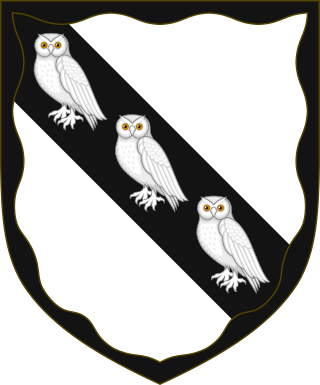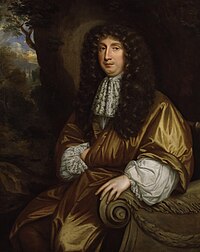
Marquess of Queensberry is a title in the Peerage of Scotland. The title has been held since its creation in 1682 by a member of the Douglas family. The Marquesses also held the title of Duke of Queensberry from 1684 to 1810, when it was inherited by the Duke of Buccleuch.

George Savile, 1st Marquess of Halifax,, was an English statesman, writer, and politician who sat in the House of Commons in 1660, and in the House of Lords after he was raised to the peerage in 1668.

The title Duke of Queensberry was created in the Peerage of Scotland on 3 February 1684 along with the subsidiary title Marquess of Dumfriesshire for the 1st Marquess of Queensberry. The Dukedom was held along with the Marquessate of Queensberry until the death of the 4th Duke in 1810, when the Marquessate was inherited by Sir Charles Douglas of Kelhead, 5th Baronet, while the Dukedom was inherited by the 3rd Duke of Buccleuch. Since then the title of Duke of Queensberry has been held by the Dukes of Buccleuch.

Earl of Scarbrough is a title in the Peerage of England. It was created in 1690 for Richard Lumley, 2nd Viscount Lumley. He is best remembered as one of the Immortal Seven who invited William of Orange to invade England and depose his father-in-law James II. Lumley had already been created Baron Lumley, of Lumley Castle in the County of Durham, in 1681, and Viscount Lumley, of Lumley Castle in the County of Durham, in 1689. These titles are also in the Peerage of England. The title of Viscount Lumley, of Waterford, was created in the Peerage of Ireland in 1628 for his grandfather Sir Richard Lumley, who later fought as a Royalist in the Civil War.

Earl of Halifax is a title that has been created four times in British history—once in the Peerage of England, twice in the Peerage of Great Britain, and once in the Peerage of the United Kingdom. The name of the peerage refers to Halifax, West Yorkshire.

Baron Savile, of Rufford in the County of Nottingham, is a title in the Peerage of the United Kingdom. It was created in 1888 for the diplomat Sir John Savile. He was the eldest of the five illegitimate children of John Lumley-Savile, 8th Earl of Scarbrough, and the grandson of John Lumley-Savile, 7th Earl of Scarbrough. The latter was the fourth of the seven sons of Richard Lumley-Saunderson, 4th Earl of Scarbrough, and his wife Barbara, sister and heiress of the politician Sir George Savile, 8th and last Baronet, of Thornhill, who bequeathed the substantial Savile estates in Yorkshire and Nottinghamshire to his nephew the Hon. Richard Lumley-Saunderson, later 6th Earl of Scarbrough. On his death the estates passed to his younger brother, the aforementioned seventh Earl, and then to his son the eighth Earl. The latter bequeathed the estates to his second natural son Captain Henry Lumley-Savile. When he died they passed to his younger brother Augustus William Lumley-Savile (1829–1887) and then to his eldest brother, the aforementioned John Savile, who was created Baron Savile the following year.

Marquess of Ripon, in the County of York, was a title in the Peerage of the United Kingdom. It was created in 1871 for the Liberal politician George Robinson, 2nd Earl of Ripon.

The title of Earl of Kenmare was created in the Peerage of Ireland in 1801. It became extinct upon the death of the 7th Earl in 1952.

The title Earl Castleton, of Sandbeck in the County of York, was created in the Peerage of Great Britain in 1720 for the 6th Viscount Castleton, who had previously been created Baron Saunderson, of Saxby in the County of Lincoln, in 1714, and Viscount Castleton, of Sandbeck in the County of York, in 1716, both also in the Peerage of Great Britain.

Sir George Savile, 8th Baronet of Thornhill FRS was an English politician who sat in the House of Commons from 1759 to 1783.

Rufford Abbey is a country estate in Rufford, Nottinghamshire, England, two miles (4 km) south of Ollerton. Originally a Cistercian abbey, it was converted to a country house in the 16th century after King Henry VIII’s dissolution of the monasteries. Part of the house was demolished in the 20th century, but the remains, standing in 150 acres of park and woodland, are open to the public as Rufford Country Park. Part of the park is a local nature reserve.

William Savile, 2nd Marquess of Halifax was the son of George Savile, 1st Viscount Halifax and Dorothy Savile, Viscountess Halifax. He was educated in Geneva in 1677 and matriculated at Christ Church, Oxford in 1681, but did not take a degree. He travelled on the continent in 1684–1687, returning on his brother's death. From that time, he was known as Lord Elland, from his father's subsidiary title of Baron Savile of Elland.

John Savile, 1st Baron Savile,, was a British diplomat who served as Ambassador to Italy from 1883 to 1888.
John Lumley-Savile, 8th Earl of Scarbrough, styled Viscount Lumley between 1832 and 1835, was a British peer and politician.

Richard Lumley-Saunderson, 6th Earl of Scarbrough, styled The Honourable Richard Lumley-Saunderson until 1807, was a British peer and politician.

Sir William Savile, 3rd Baronet of Thornhill was an English politician who sat in the House of Commons between 1640 and 1642. He fought on the Royalist side in the English Civil War and was killed in action.

Sir George Savile, 7th Baronet,, of Thornhill, of Rufford Nottinghamshire, was an English politician who sat in the House of Commons from 1728 to 1734.

Sir George Savile, 1st Baronet of Thornhill, was an English politician and the lineal ancestor of the Marquesses of Halifax.

Lieutenant-Colonel Richard George Lumley, 9th Earl of Scarbrough was an Anglo-Irish peer and soldier.
Halifax is an English surname.















